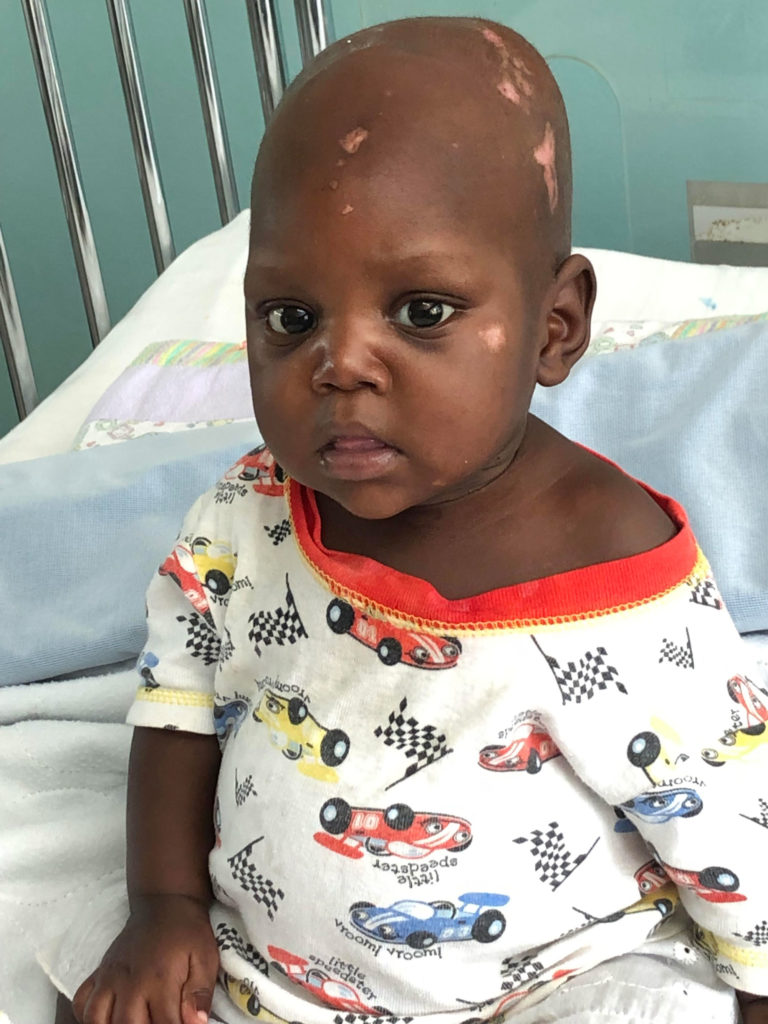Malnutrition programme saving lives at St. Damien Hospital
The successful treatment of a malnourished toddler demonstrates the 3 phases of St. Damien’s malnutrition treatment programme.
Denia is a 28-year-old mother of three boys: a 6-year-old, a 2-year-old, and an 11-month-old named Wood*. The family is from Gwo Cheval in the southeast region of Haiti, a 5-hour drive from NPH St. Damien Hospital.
A mother’s eye detected that Wood was not well. Denia noticed swelling in parts of his body and immediately took him to a doctor. When the local doctor was not able to help Wood, the toddler was transferred to St. Damien for further tests.
Diagnosis with severe malnutrition

At St. Damien, doctors diagnosed Wood with severe malnutrition, septicaemia, and abscesses on his head. He was transferred to the critical care unit, where he spent 15 days being treated for all of his medical ailments. For Wood, and many other children who suffer from malnourishment, treatment rarely ends after just 2 weeks. Children with severe malnutrition are usually hospitalised for 6 weeks and treated on a schedule based on national protocols. But due to the seriousness of Wood’s malnutrition, he spent 4 months at the St. Damien Malnutrition Care Unit.
The unit treats children from many areas of the country. Patients first receive a special liquid formula made of mild multivitamins and oligo elements. Fortified peanut butter is administered, as well. According to our own protocols, St. Damien’s malnutrition programme has 3 phases to best support a patient through recovery.
Phase One: Stabilisation
St. Damien provides transfusions to the patients, if needed, and immediately works to rehydrate them. Intensive feeding also starts immediately, using trimethoprim/sulfamethoxazole, mebendazole, folic acid and zinc cream. Therapeutic milk is also given.
Wood is currently in between stages one and two. He has stabilized and his swelling is disappearing.
Phase Two: Transition
The focus in phase two is on regaining weight. In Wood’s case, however, he was 5.72 kilograms upon arrival to St. Damien, but much of that weight came from his severe swelling. After 40 days in the malnutrition ward, he now weighs 5.5 kilograms, but this decrease in weight is not worrying doctors, who say his body needed to slim down to prepare for regaining healthy weight. Wood will need to weigh at least 6.8 kilograms before transitioning out of the malnutrition ward.
Phase Three: Recuperation
Children receive peanuts, cereals, pasta, and counselling to help address both their physical and mental health following their time in the malnutrition ward. The outpatient programme runs for about 6 weeks and provides patients with food packages comprising dried energy milk, peanuts, cereals, and pasta fortified with a mix of vitamins and minerals that are designed to counter the specific biochemical effects of malnutrition in children. Dedicated professionals also provide counselling to parents as they prepare to head back home with their children. Patients remain in this third phase until they have regained the necessary weight to be classified at a healthy level.
Wood’s mother is thankful to St. Damien, saying that, after seeing how much he has improved, she knows that the hospital helped him survive.
More about malnutrition in Haiti
Find out more about malnutrition in Haiti from Meds & Food for Kids.
*Children’s names have been changed to protect their privacy.
